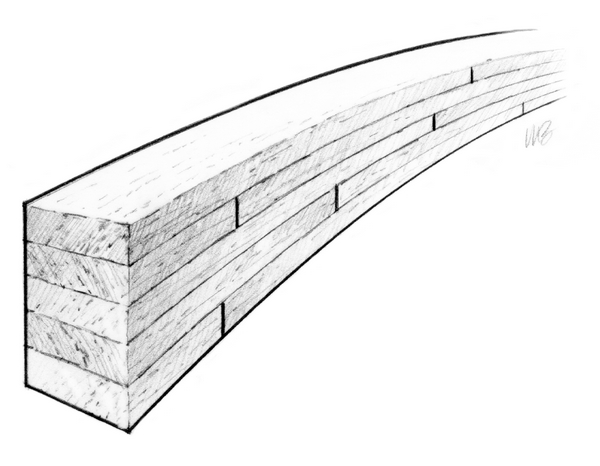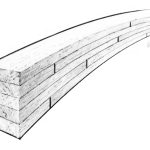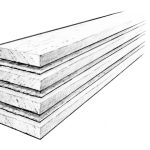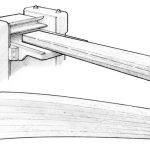
By Captain James R. Watson
When I was a kid, my older brother had a slingshot that was fashioned from a tree crotch. The wood fibers neatly followed the desired shape and nicely addressed the forces when operated. Centuries ago, many large ship components — knees, hooks, and floors were selected from forks, crotches and crooks of trees for much the same reasons. One-piece wooden parts were very reliable and the naturally grown beams and frames were key components of ship construction. As the availability of large naturally shaped timber diminished, large curved components were made of stacked and mechanically fastened smaller pieces of wood. Laminated wood structures weren’t possible until the relatively recent development of strong adhesives.
It is somewhat misleading to say that laminated wood superior in strength to solid wood. Wood fiber is wood fiber. What jeopardizes strength and reliability of a one-piece beam are its inherent defects. Strength and stiffness would be predictable and reliable if flaws such as knots, grain runout, grain dive and pitch pockets could all be detected and evaluated. To compensate for the possibility of hidden weakness designers are inclined to over-engineer by using heavier solid timbers. These days, the use of solid timber is limited to components that are mostly short and straight.
Laminating advantages
The reality of flaws in solid wooden components underscores the advantages of laminating wooden parts. With laminating, you can assemble the pieces, or plies, of a laminate stack to build a part to a specific shape (almost as if it grew to that shape) — orienting wood grain to address predicted stresses, minimizing waste, and reducing and dispersing flaws.
Joints can have the same effect as flaws in wood structures. The number of joints are often dictated by availability of good lengths of flawless timber. In solid wood components scarf joints are employed to join shorter timber end to end in an effort to maintain strength across the joint. Simpler joining methods such as butt joints require much less labor, but are much weaker and are stress concentrations. Where butt joints may be out of the question for solid timber construction, laminating allows you to use butt joints, because each joint has less effect on the overall strength of the part and joints, like flaws, can be evenly distributed throughout the part.
Orienting wood grain
The load on beams and frames is generally unidirectional. The wood grain in both solid and laminated beams generally runs in one direction, parallel to the long axis of the beam. For structural components that do not carry a simple unidirectional load, laminating offers the opportunity to adjust the grain to the load direction. Although wood is much stronger along the direction of the grain, laminated wood can be made stronger across the grain by incorporating plies in directions other than the primary grain direction. By orienting every other layer 90°, plywood panels, for example, become stiff in two directions. While a strip of plywood would make a pretty poor beam, skewing laminations 5° to 10° from the long axis of the piece will improve cross-grain strength, but the piece would still be strong in the primary load direction. One advantage of skewing fibers at an angle is that it orients fibers more gradually throughout a bend, exerting less stress and allowing greater ply thickness.
Thinner is better
Choose the wood for a particular structure or part based on strength, stiffness, weight, cost, availability, the builder’s abilities, bondability and workability. All materials have a maximum bending radius — before compression or tension damage begins. If the wooden ply will not negotiate the bend at a given thickness, then thinner material is required. Thin materials negotiate a bend more easily than thick ones and more laminations of thinner material better resist springback.
Also, when wood is sliced into thin plies, trapped stresses are relieved; when bonded back together the resulting laminate is more dimensionally stable — able to resist the swelling, shrinking or warping that a thick one-piece component may produce (especially when exposed to fluctuations in humidity.) A good example of the value of thin laminations is in a guitar neck where stability translates into more consistent tuning.
Variations that improve basic laminating
As with any technique, there are variations of basic methods that can improve wooden laminates:
- Improve the strength-to-weight ratio by placing higher density wood furthest from neutral axis and lighter density close to neutral axis.
Often it makes sense to place high-modulus/high-strength wooden plies, such as ash or mahogany, furthest from the neutral axis (top and bottom), and lighter, weaker materials such as cedar or spruce in the center. This method puts the stronger, heavier materials where the loads are the greatest and lighter materials where the loads are less, much like building an I-beam. It offers greater strength with less weight. - Customizing laminates by visually grading veneers or selecting light and dark layers for aesthetics.
Because wood has a number of natural flaws, it is wise to take precautions to reduce or diffuse them with a grading procedure. After a board has been ripped into thinner plies, flip alternate pieces end-for-end. On important structural components, lay the plies out and visually locate flaws (knots, grain run out or irregular grain pattern) and eliminate them if they are excessive, or spread them evenly throughout the total laminate. You can also separate plies by weight or color and use the best one for the top and bottom plies. For aesthetics, many people like to alternate light and dark colored woods — alternating ash and mahogany, for example. - Augmenting laminations with man-made reinforcing fibers for strength.
A good way to beef up a unidirectional wood laminate is to augment plies with unidirectional synthetic reinforcing fibers — fiberglass, carbon, Kevlar® — adding considerable strength with a minimum weight gain. Strength can be improved further by placing these materials away from the neutral axis of the beam.Laminates with good cross-grain strength can be created by skewing plies of unidirectional fibers or by incorporating woven or bi-axial fabrics to give the laminate cross-grain reinforcement without significantly increasing laminate thickness. - Tapering individual plies can eliminate endgrain exposure and ply runout on tapered laminates.
It is tough to taper a laminated beam with saws and planes after it is laminated. A nice approach to use when building tapered beams or beams with tapered ends is to taper individual plies prior to laminating. After the “glue-up,” except for cleaning excess adhesive and finishing the sides of the beam, the work is done. In addition to facilitating production, this approach holds the advantage of eliminating exposed endgrain and nearly eliminates grain runout in the taper. It is structurally and aesthetically superior.To taper the laminates individually, first determine the amount of taper in each ply, from the thickest cross section to the thinnest. Then make a master that is the reverse of each ply. The master will support each ply as it is passed through a thickness planer. The planer will remove the most material from the ply over the thickest part of the master. All of the plies will be tapered identically and when laminated only the sides of the component need finishing.
Forms for curved frames or beams
Layout the desired curved shape of the part onto any flat work surface (a floor or a bench). Attach triangular knees or cleats along one side of the line of the curve. To keep the laminate from bonding to the work surface place a plastic sheet under the cleats. Attach an additional cleat opposite each cleat on the line. Leave enough space between opposing cleats to easily fit the epoxy coated plies. When all of the plies are positioned, insert wedges between second row of cleats and the ply stack. Tap the wedges in to clamp the laminate firmly and evenly against the first row of cleats.
Ideally, enough epoxy is applied to all mating surfaces so that a small amount squeezes out as clamping pressure is applied. Even contact is all that is required between mating surfaces — too much clamping pressure only pre-stresses joints and forces adhesive from the joint, which could result in a glue starved joint.
Be careful that the plastic does not find its way between plies when drawing them together. Cover the cleats and clamps with plastic to keep them clean. Spraying mold-release on clamps is also a good idea.
Laminated parts can offer many advantages to the builder. As with most projects, planning ahead is the key to success. A little innovation also goes a long way.








